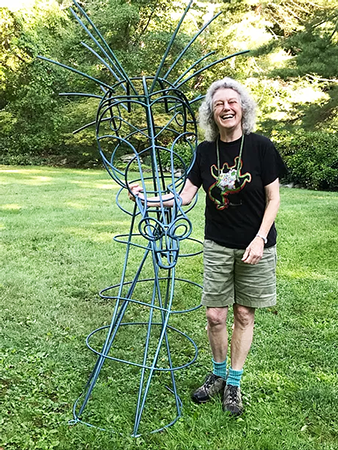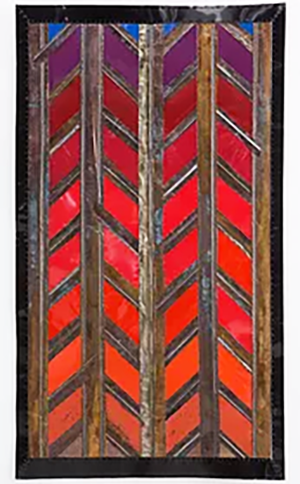Robin Tost: Giving Form to the Discarded
“I was always fiddling with sculpture from the time I was little,” explains metal sculptor Robin Tost. “I liked putting things together.”
For much of her life, it wasn’t her primary form of artistic expression. In college she tried her hand at creating masks for the theater department. This led her to making puppets and, for a time, paper mâché people. “I ran out of steam on that because, unfortunately, people wanted the same things over and over again,” she recalls. “To be honest, I got bored of it.”
 Copper artist Robin Tost and her work.
Copper artist Robin Tost and her work.Photograps courtesy of Robin Tost.
Her exploration of sculpture began in earnest when a stranger approached her about exhibiting some of her work in a local art gallery. “That was fun,” Tost says, reflecting on the experience. “Then I started putting things together more seriously.”
It wasn’t until years later that she began incorporating metal quilting into her work. She was on a bike trip in Vermont, touring a region where closed factories were a regular sight. The economic situation of the area struck Tost. It wasn’t uncommon to find women selling quilts, hoping to supplement their husbands lost income. The juxtaposition between these fabric quilts and the harshness of abandoned industry proved to be a source of inspiration.
“I thought ok, we’ll combine them,” she says. “We’ll use the men’s materials and the women’s quilts.”
This is how she got her start in metal quilting. A strong proponent of recycling, she sources her scrap metal from a nearby transfer station and a local automotive shop. Sometimes she’s lucky enough to come across rarer metals, as was the case recently when a friend provided her with a cache of blue copper. “It’s all blue and green, and in various shapes,” she says “It’s really nice stuff.”

Closeup image of Robin Tost's copper art.
Color is, to Tost, one of the most important aspects to consider when it comes to sourcing material. She prioritizes it above the type of metal itself, and prefers to preserve the materials natural color in her work. There are, however, other considerations to be made. “My hands aren’t as strong as they used to be,” she explains. “Copper, if I can get it, is absolutely wonderful. It’s easy to cut and it’s malleable. Now my structures are getting more rounded, so bent copper is wonderful.”
Much like the sourcing of her materials, her artistic process involves the community. She creates the initial form of her sculptures with copper wire or paper mâché, and a local metalworking artist helps her create her frames out of steel. Her metal quilts she creates by forming patterns out of the metal scrap, cutting them into shape, punching their edges with a drill press and sewing them together with wire.
The blue copper she lucked into is being put to use in her next piece, Serpent. “It’ll probably take me a year and a half, because it’s a huge thing,” Tost says. “This thing is in four pieces, so it’s almost like four sculptures.” The serpent stands as a visual representation of the malleability she values in copper.
She recently showcased work at the annual Flying Horse Outdoor Sculpture Exhibit, hosted by the Pingree School in South Hamilton, Massachusetts. Robin’s piece Navajo Sunset was included this year. Built out of an old solar panel and featuring copper made to resemble trees, the piece speaks to her dedication to recycling.
Robin also created a mini-documentary recently called Spirit Bear. “I kind of knew it was going to be that bear,” she said, reflecting on the titular piece’s conceptual genesis. Her inspiration here, as with much of her work, seems drawn from the natural world. “I like bears,” she says. “I grew up in White Bear Lake, Minnesota.”
Perhaps, then, her focus on reflecting natural beauty in recycled scrap can be traced back to her earliest days. Her love of art certainly can.
“I was given a choice between music and art,” she recalls. “I chose art.”
Resources:
Also in this Issue:
- Copper Artist Ronald Stauffer Honored by Amazon
- Robin Tost: Giving Form to the Discarded
- Copper Sculptor Ruth Asawa Celebrated by USPS With Line of Commemorative Stamps
- Copper’s Place in Pennsylvania German Metalwork
- Grounds for Sculpture Remains Open for Winter Viewers
